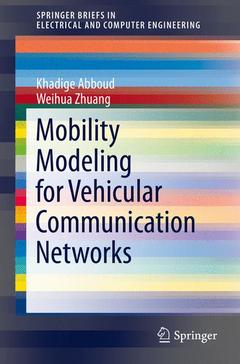Mobility Modeling for Vehicular Communication Networks, 1st ed. 2015 SpringerBriefs in Electrical and Computer Engineering Series
Auteurs : Abboud Khadige, Zhuang Weihua

This brief presents a stochastic microscopic mobility model that describes the temporal changes of intervehicle distances. The model is consistent with simulated and empirical vehicle traffic patterns. Using stochastic lumpability methods, the proposed mobility model is mapped into an aggregated mobility model that describes the mobility of a group of vehicles. In addition, the proposed mobility model is used to analyze the spatiotemporal VANET topology.
Two metrics are proposed to characterize the impact of vehicle mobility on VANET topology: the time period between successive changes in communication link state (connection and disconnection) and the time period between successive changes in node?s one-hop neighborhood. Using the proposed lumped group mobility model, the two VANET topology metrics are probabilistically characterized for different vehicular traffic flow conditions. Furthermore, the limiting behavior of a system of two-hop vehicles and the overlap-state of their coverage ranges is modeled, and the steady-state number of common vehicle neighbors between the two vehicles is approximately derived. The proposed mobility model will facilitate mathematical analysis in VANETs. The spatiotemporal VANET topology analysis provides a useful tool for the development of mobility-aware vehicular network protocols.
Mobility Modeling for Vehicular Communication Networks is designed for researchers, developers, and professionals involved with vehicular communications. It is also suitable for advanced-level students interested in communications, transport infrastructure, and infotainment applications.Includes supplementary material: sn.pub/extras
Date de parution : 03-2016
Ouvrage de 63 p.
15.5x23.5 cm
Disponible chez l'éditeur (délai d'approvisionnement : 15 jours).
Prix indicatif 52,74 €
Ajouter au panier


